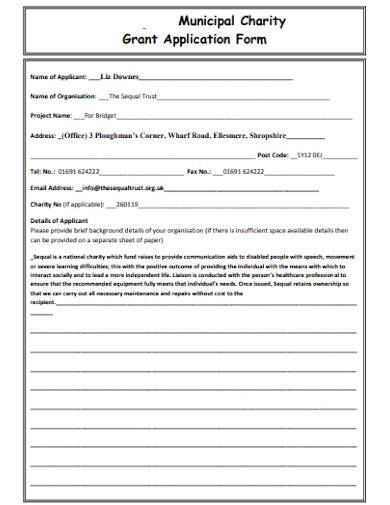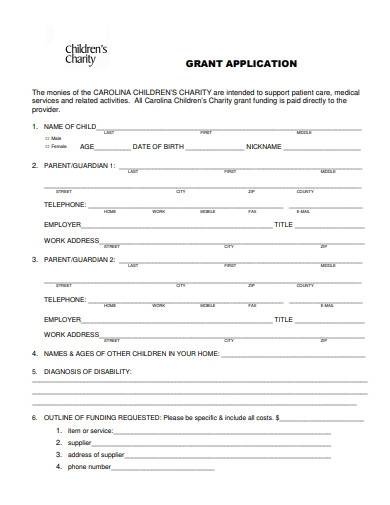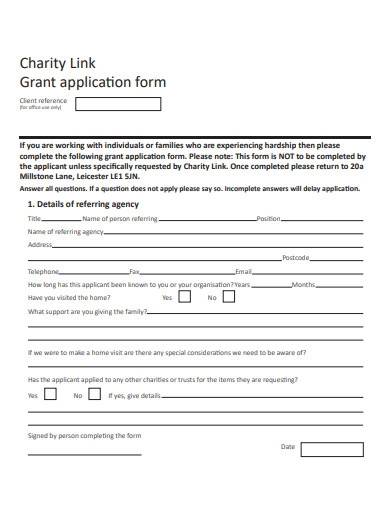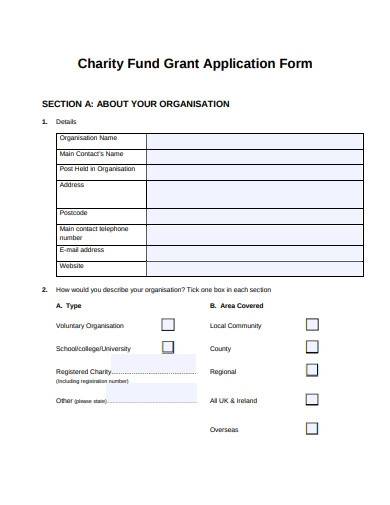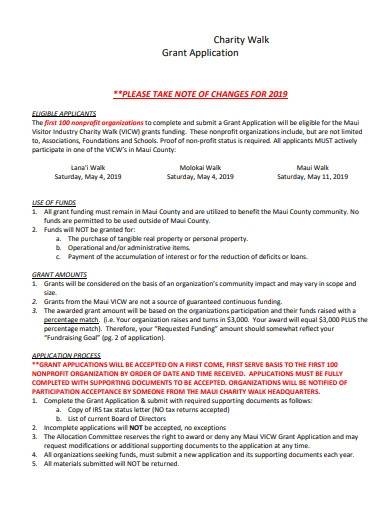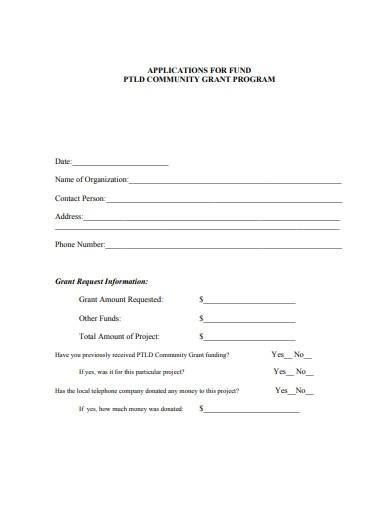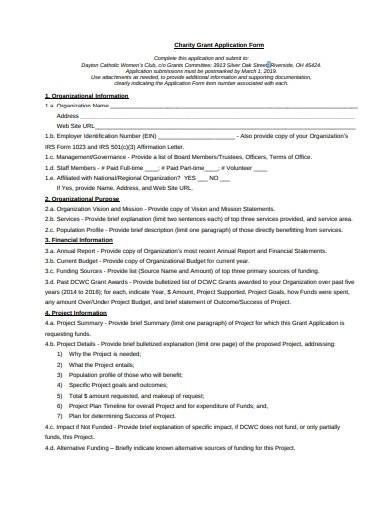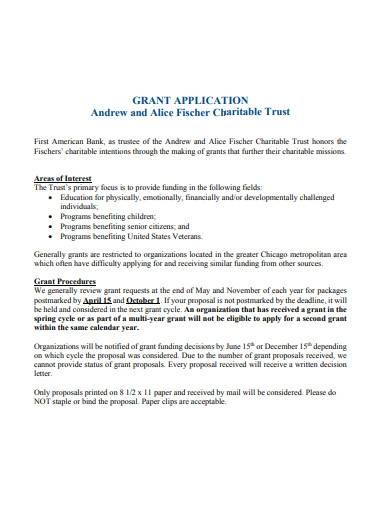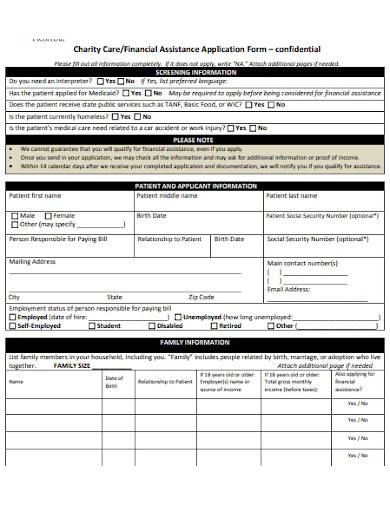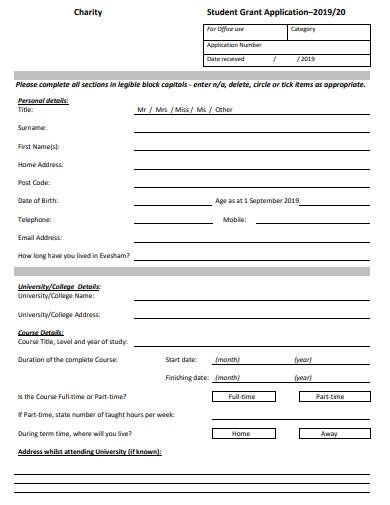Nonprofit organizations and charities can’t function well enough without the sponsors’ and donors’ provisions. Every financial transaction and decision gets affected by every change in the charity budget plan. Luckily, there are various ways to get sponsorships such as grants, be it from an individual or a company. And one way to apply for it requires the use of charity grant application forms. Don’t know what that is? Or maybe you aim to make one from scratch? Then, scroll down to read more about this essential document!
FREE 10+ Charity Grant Application Samples & Templates in PDF
1. Charity Grant Application Form
2. Municipal Charity Grant Application Form
3. Sample Children Charity Grant Application
4. Charity Grant Application Form Template
5. Charity Fund Grant Application Form
6. Charity Walk Grant Application Sample
7. Charity Fund Grant Application Form
8. Basic Charity Grant Application Form
9. Trust Grant Application Template
10. Charity Care Application Form
11. Student Charity Grant Application Form
How to Use a Charity Grant Application Form
There are many different ways to find grants for your nonprofit or charity organization, and one is by searching through the internet, as well as by contacting state agencies who can put your organization in line as a grant recipient. But, when it comes to filling up the application form, regardless of the type of grant you are applying for, you must keep the following tips in mind:
1. Read the Instructions First
Every application form and legal document has varying instructions as it depends on the purpose and the aim of using it. So, you should first head on to read the instructions in each section of the charity application form. Take note of any submission methods as well as the preferred pen color or fonts and attachments that you must fulfill as part of your application. Also, make sure to add “NA” in any entry field that requires the disclosure of data and information, but does not apply to your charity organization.
2. Avoid Making Mistakes
Humans make mistakes. But, when it comes to the aspect of finances and in managing a charitable organization to have a grantor, mistakes are not welcome. Therefore, before you even enter your answer in each available field, think first! This is crucial, especially if you have printed out the charity grant application template and will be using a pen to fill it out. On the one hand, when using the application form electronically, you will be able to avoid mistakes by double-checking and reviewing your answers and the contents of your application.
3. Never Sugar-Coat Your Answers
Lies are lies, regardless of how much you turn it around and around; so, just forgo sugar-coating your answers, top to bottom! Accuracy is the key to building a well-rounded and strong relationship with anyone, including your prospective grantors and donors. Also, if you deem that a piece of data or information is confidential, then you simply inform the one whom you will be submitting the application form to. You can even state in the application form that you prefer to disclose the specific data in a separate document, for it’s private. This way, you are maintaining your charity data protection privacy, and establish trust and honesty to the agency managing your application.
And lastly, check your grammar and spelling. Yes, you may be an expert in using the English language in writing or in any other language that you will be using in the application form, but it’s always better to prevent than to realize what your errors are. And don’t forget that your application should look and convey professionalism. This means that there should be no immature content or statements included, as well as those which are not relevant to your purpose of applying for the grant.
FAQ’s
What is a charity grant application form?
A charity grant application form is the document that you can use to apply for funding from different entities or corporations who may want to be grantors to support your charity. The layout and contents or specific data and information collected in a charity grant application form highly depends on the one who provided it to your charity.
Why should charity grant application forms be used?
Charity grant applications are used because these documents help grantors choose or select which charity they will be grantors of. It allows grantors to know the details of the charity and determine whether the charity’s goal and purpose meet with the grantor’s aim in his sponsorship. For instance, grantors who are into helping animals and wildlife will most likely choose charitable organizations who focus on the same subject. In contrast, grantors who prefer lending a hand to support those who don’t own homes will choose homeless shelters as their grantees or recipients.
Is a charity application form a legal form?
A document becomes a legal form if it bears a notary seal, as well as the details of a court or a case such as a case docket number and case name. Therefore, charity application forms are not legal forms, but they are essential documents that you must fill out with absolute accuracy, regardless of where you will be sending or submitting the completed version of it.
To conclude, charity grant application forms serve as tools that gather details and evidence of a charity’s needs. After all, it’s essential that the right type of help, be it financial or in-kind, gets delivered to the right recipient. Aside from that, the form is also beneficial in documenting active charity organizations in a state. By this, the state will be able to update its records and identify if a charity is one of those who successfully submitted a charity registration or those who failed to comply with the state’s nonprofit organizations’ policies and rules.
Related Posts
FREE 10+ Charity Mission Statement Samples and Templates in MS Word | PDF
FREE 10+ Charity Pay Policy Samples & Templates in MS Word | PDF
FREE 5+ Charity Investment Policy Samples & Templates in MS Word | PDF
FREE 10+ Charity Privacy Policy Samples & Templates in MS Word | PDF
FREE 10+ Charity Standing Order Form Samples & Templates in MS Word | PDF | MS Excel
FREE 10+ Charity Risk Management Policy Samples & Templates in PDF
FREE 3+ Charity Investment Strategy Samples & Templates in PDF | MS Word
FREE 5+ Charity Marketing Policy Samples & Templates in PDF
FREE 5+ Charity Recruitment Policy Samples & Templates in MS Word | PDF
FREE 3+ Charity Management Accounts Samples & Templates in PDF
FREE 10+ Charity Gift Aid Form Samples & Templates in MS Word | PDF
FREE 10+ Charity Strategy Samples & Templates in MS Word | PDF
FREE 6+ Charity Marketing Strategy Samples & Templates in MS Word | PDF
FREE 10+ Charity Financial Policy Samples & Templates in MS Word | PDF
FREE 10+ Charity Financial Policies and Procedures Samples & Templates in MS Word | PDF


